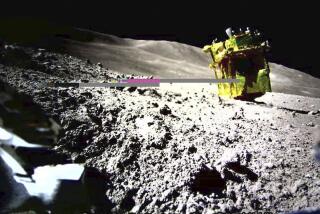On Mars: ‘It must be ice’
- Share via
Images from NASA’s Phoenix lander released late Thursday appeared to confirm the presence of buried ice, the first evidence that the spacecraft landed in the right spot last month to find water on Mars.
Pictures taken of a trench dug earlier in the week by the lander’s nearly 8-foot-long robotic arm showed that eight small, whitish chunks of material at the base of the trench had disappeared by Thursday.
If those chunks had been some form of salt, as some scientists believed, they would not have evaporated, said Peter Smith of the University of Arizona, the lead scientist for the $420-million mission.
“It must be ice,” Smith said. “These little clumps completely disappearing over the course of a few days, that is perfect evidence that it’s ice. This has been a wonderful day.”
Phoenix parachuted to the Martian north pole May 25 with the primary goal of finding water, which is crucial for determining whether the planet ever was, or still might be, habitable for rudimentary forms of life.
Water is also a key element of NASA’s long-range dreams to send humans to the Red Planet because it not only would be necessary to sustain the first generation of pioneers, but would be a source for fuel.
The orbiting Mars Odyssey spacecraft in 2002 detected large quantities of hydrogen below the surface at the poles, which scientists said indicated vast quantities of ice. But even though the lumpy, fissured landing site on a northern Martian plain reminded some geologists of Earth’s Arctic, the science team could not be sure they had landed in the right place.
Unlike the twin Martian rovers Spirit and Opportunity, Phoenix is incapable of movement, so tension was high among the scientists at the University of Arizona and the Jet Propulsion Laboratory in La Canada Flintridge, which is managing the mission for NASA.
Also unlike the rovers, Phoenix will not have a long life. The arrival of the Martian winter in a few months will coat it with carbon dioxide ice, preventing its solar cells from gathering any sunlight.
Nearly two weeks ago, the lander’s robotic arm began digging into the soil. On Sunday, it enlarged the trench that scientists named Dodo-Goldilocks. At one edge of the 2-inch-deep trench were eight chunks of whitish material, each less than an inch across.
Over the last few days, the science team kept an eye on the trench, even as they began digging a fresh trench in a region called Wonderland.
By Thursday, all eight chunks had disappeared, probably through a process called sublimation. Because the Martian atmosphere is so thin and cold, ice doesn’t melt. It simply turns into gas.
Smith said the scientists think the chunks were ripped off a larger, “parent ice body” still hidden under the clumpy soil of the northern plains.
At the same time, Smith revealed that Phoenix’s robotic arm went into safe mode while digging in a trench called Snow White 2 because it hit something very hard at about the same depth as the chunks in Dodo-Goldilocks.
Smith thinks that is a larger ice layer.
The material in Snow White 2 is a little darker, “kind of bluish,” Smith said.
The apparent ice layer is in exactly the place, and at exactly the depth, where Odyssey predicted, he said.
If the Snow White 2 material is a block of ice, it could be too hard for the scoop to break into. But the arm also contains a rasping tool to grind into large ice bodies.
Even before the launch, scientists had predicted the ice on Mars wouldn’t be like ice on Earth. In the frigid Martian weather, it could be as hard as cement.
Though Smith and the other members of the science team are now confident they’ve found ice, the final confirmation won’t come until they transport the material into one of eight tiny ovens attached to the “thermal and evolved-gas analyzer” and cook it to see what it’s made of.
That could have to wait as long as two weeks, Smith said, while Phoenix’s handlers finish dealing with what he called a “one in a billion” software glitch that swamped the lander’s computers with data.
They also will be finishing the analysis of soil samples that have already been dug up.
Even with the glitches the mission has encountered, it is ahead of schedule, according to project manager Barry Goldstein of JPL.
--






